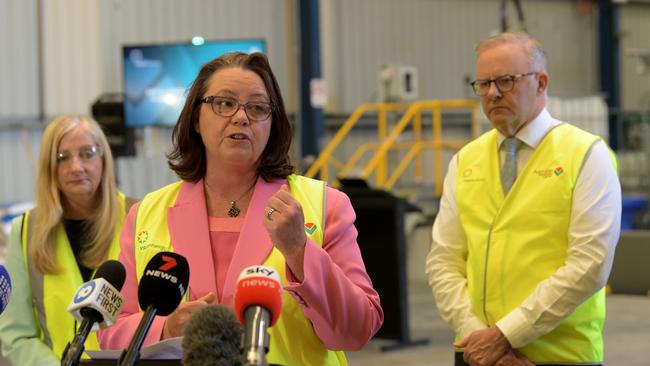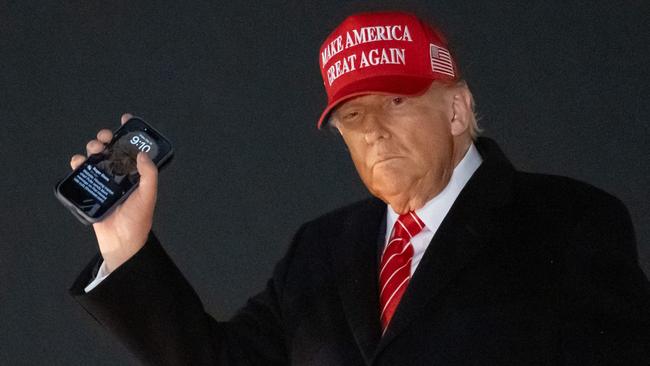
It’s important for Australia that before our Prime Minister meets US President Donald Trump, our Resources Minister Madeline King gives Anthony Albanese a full briefing on the potential of our leading global position in nuclear and mining treatment research. It would solve America’s desperate shortage of terbium, dysprosium and other heavy rare earths.
Heavy rare earths are essential in missile, drone and other defence-related technologies plus computer and industrial applications, particularly those that require strong magnets. China controls more than 90 per cent of the supply and has placed an embargo on exports to the US.
Australia is developing hard rock and clay sources of heavy rare earths but, separately in new deposits, our global technology leadership gives us the chance to break China’s monopoly.

Linked to new rare earths technology is the potential for Australia to impact global steel industry practices. And the decision by Environmental Minister Murray Watt to enable Woodside to expand its North West Shelf gas operation transforms the potential of the iron technology.
In the discussion on steel tariffs, Albanese might say to Trump: “Donald, maybe we can also help you on steel given we are already a major US steel producer.”
It’s important for the PM to emphasise. This is one of Australia’s greatest technology plays but like all technology developments, there is no certainty that it will all come to pass. The US President’s best friends are technology billionaires so he knows the technology risk game.
Leading the technology push are old school miners like Malcolm Broomhead (former BHP director and current Orica chairman), former WMC chief executive Hugh Morgan and former BHP and Norilsk Nickel executive Edwin van Leeuwen. Albanese can throw in their names, but it would be unwise to tell President Trump that the origins of the technology thrust come from statistics as much as geology because of the deep involvement of an opinion pollster, Gary Morgan.

The US is demanding Australia spend more on defence – and they are right – but politically, Albanese has sprayed too much money elsewhere. To reduce the US pressure, he can now argue that we may be in a position to save both the US and European defence capability, so perhaps US defence demands can be deferred.
We are looking at two separate technology thrusts to produce terbium and dysprosium.
The AUKUS Submarine project will obviously be discussed in the Trump-Albanese talks, so we should start with the application of nuclear medical technology to mining treatment.
Australia’s government owned ANSTO organisation operates a nuclear reactor at Lucas Heights in Sydney and can extract the rare earth Lutetium-177 from base material.
In combination with a German group, Australian cancer researchers used ANSTO’s Lutetium-177 to produce a low-cost, prostate cancer treatment.
The Swiss, who have a similar but more expensive cancer treatment, are trying to block the use of Australian-German product on patent grounds.
The facts that came out of the dispute highlighted ANSTO’s ability to separate out the Lutetium rare earth. It is highly likely that as they can separate Lutetium, they can also separate out terbium and dysprosium.
Some decades ago, BHP did extensive drilling is areas around the Bamboo Creek in WA looking for gold.
BHP walked away but the leaseholder, Morgan family-controlled Haoma, stored the cores in an old gold mine and has done other work on the site.
Analysis shows the material is rich in terbium and dysprosium.
The iron ore path to terbium and dysprosium is less speculative. Around the Pilbara there are large deposits of low-grade hematite iron ore which only a few miners have exploited because it is more economical to export high-grade hematite.
Some iron ore miners concentrate on higher grade magnetite, and some green steel projects are also based around magnetite ore.
But many low-grade hematite ores also contain gold and heavy rare earths like terbium and dysprosium.
The boom in the price of these materials means that if they can be extracted, it changes the economics of mining and developing these low-grade hematite orebodies. The Chinese are already extracting rare earths before producing pig iron.
The first step in treating these low-grade hematite orebodies is to remove the gold and some of the heavy rare earths with what is known as the ‘‘Elazac’’ process, which is currently being used to extract gold and other minerals from tailings dams in the Bamboo Creek area. A pilot plant is being erected to use the ‘‘Elazac’’ process for that vital, first step in treating low-grade hematite.
The iron ore, removed of most of its gold, terbium and dysprosium, could then be treated in an electric arc furnace powered by a combination of solar energy and Woodside gas that has been enhanced by the inclusion of geothite (low trade iron ore containing oxygen atoms).
The oxygen in goethite improves the economics of the process.
Using different temperatures, further rare earths are extracted plus other minerals.
The remaining product is pig iron, which can be converted to steel in the Pilbara, but is more likely to be sent to Europe or Japan. But conceivably it could go to the US as part of a rare earths deal.
Best of luck, PM.





BeyondWords Text to Speech David's voice